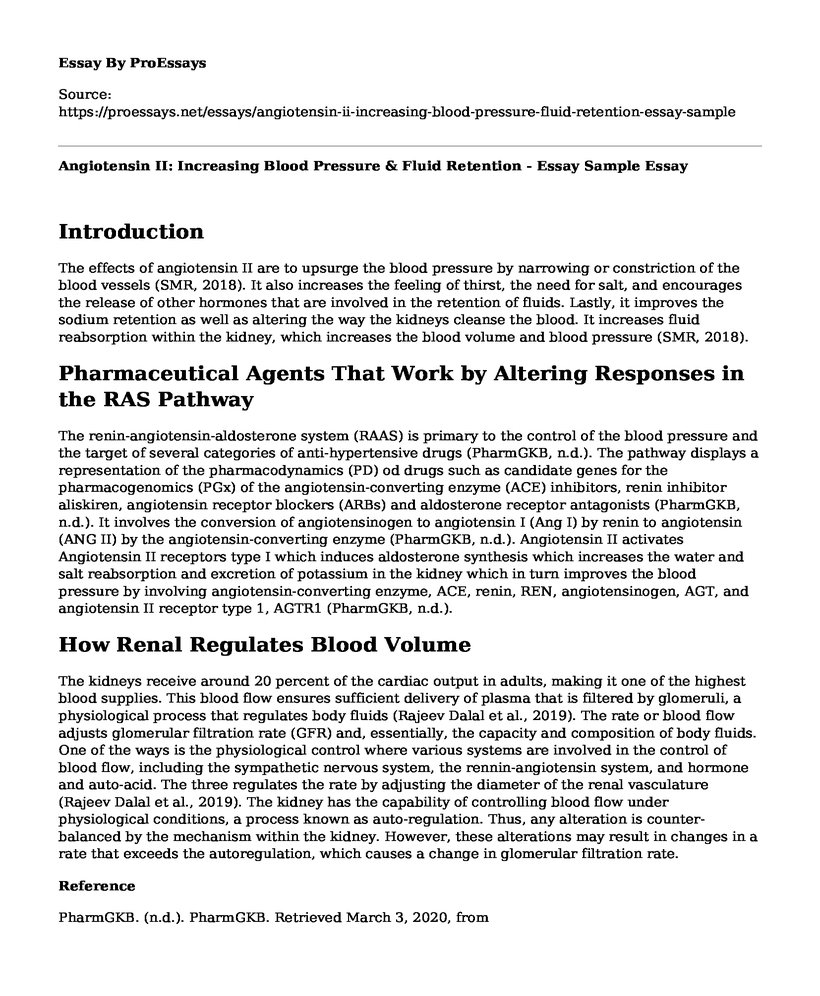Introduction
The effects of angiotensin II are to upsurge the blood pressure by narrowing or constriction of the blood vessels (SMR, 2018). It also increases the feeling of thirst, the need for salt, and encourages the release of other hormones that are involved in the retention of fluids. Lastly, it improves the sodium retention as well as altering the way the kidneys cleanse the blood. It increases fluid reabsorption within the kidney, which increases the blood volume and blood pressure (SMR, 2018).
Pharmaceutical Agents That Work by Altering Responses in the RAS Pathway
The renin-angiotensin-aldosterone system (RAAS) is primary to the control of the blood pressure and the target of several categories of anti-hypertensive drugs (PharmGKB, n.d.). The pathway displays a representation of the pharmacodynamics (PD) od drugs such as candidate genes for the pharmacogenomics (PGx) of the angiotensin-converting enzyme (ACE) inhibitors, renin inhibitor aliskiren, angiotensin receptor blockers (ARBs) and aldosterone receptor antagonists (PharmGKB, n.d.). It involves the conversion of angiotensinogen to angiotensin I (Ang I) by renin to angiotensin (ANG II) by the angiotensin-converting enzyme (PharmGKB, n.d.). Angiotensin II activates Angiotensin II receptors type I which induces aldosterone synthesis which increases the water and salt reabsorption and excretion of potassium in the kidney which in turn improves the blood pressure by involving angiotensin-converting enzyme, ACE, renin, REN, angiotensinogen, AGT, and angiotensin II receptor type 1, AGTR1 (PharmGKB, n.d.).
How Renal Regulates Blood Volume
The kidneys receive around 20 percent of the cardiac output in adults, making it one of the highest blood supplies. This blood flow ensures sufficient delivery of plasma that is filtered by glomeruli, a physiological process that regulates body fluids (Rajeev Dalal et al., 2019). The rate or blood flow adjusts glomerular filtration rate (GFR) and, essentially, the capacity and composition of body fluids. One of the ways is the physiological control where various systems are involved in the control of blood flow, including the sympathetic nervous system, the rennin-angiotensin system, and hormone and auto-acid. The three regulates the rate by adjusting the diameter of the renal vasculature (Rajeev Dalal et al., 2019). The kidney has the capability of controlling blood flow under physiological conditions, a process known as auto-regulation. Thus, any alteration is counter-balanced by the mechanism within the kidney. However, these alterations may result in changes in a rate that exceeds the autoregulation, which causes a change in glomerular filtration rate.
Reference
PharmGKB. (n.d.). PharmGKB. Retrieved March 3, 2020, from https://www.pharmgkb.org/pathway/PA165110622
Rajeev Dalal, Bruss, Z. S., & Sehdev, J. S. (2019, May 15). Physiology, Renal Blood Flow and Filtration. Nih.Gov; StatPearls Publishing. https://www.ncbi.nlm.nih.gov/books/NBK482248/
SMR, A. (2018). Angiotensin II Contributes to the Pathophysiology of Heart Failure. Open Access Journal of Pharmaceutical Research, 2(4). https://doi.org/10.23880/oajpr-16000169
Cite this page
Angiotensin II: Increasing Blood Pressure & Fluid Retention - Essay Sample. (2023, Apr 12). Retrieved from https://proessays.net/essays/angiotensin-ii-increasing-blood-pressure-fluid-retention-essay-sample
If you are the original author of this essay and no longer wish to have it published on the ProEssays website, please click below to request its removal:
- Epidemiology for Public Health Practice Paper Example
- Nursing Transition Paper
- Essay Sample on Obesity is a Health Hazard not a Disease
- Affordable Care Act and Patient Advocacy Essay Example
- Mayo Clinic: Leading Nonprofit for Health Research and EHR Implementation - Research Paper
- Global Employment & Underemployment: COVID-19 Impact & Solutions - Essay Sample
- Nursing Theories: Foundations for Nursing Practice - Essay Sample







